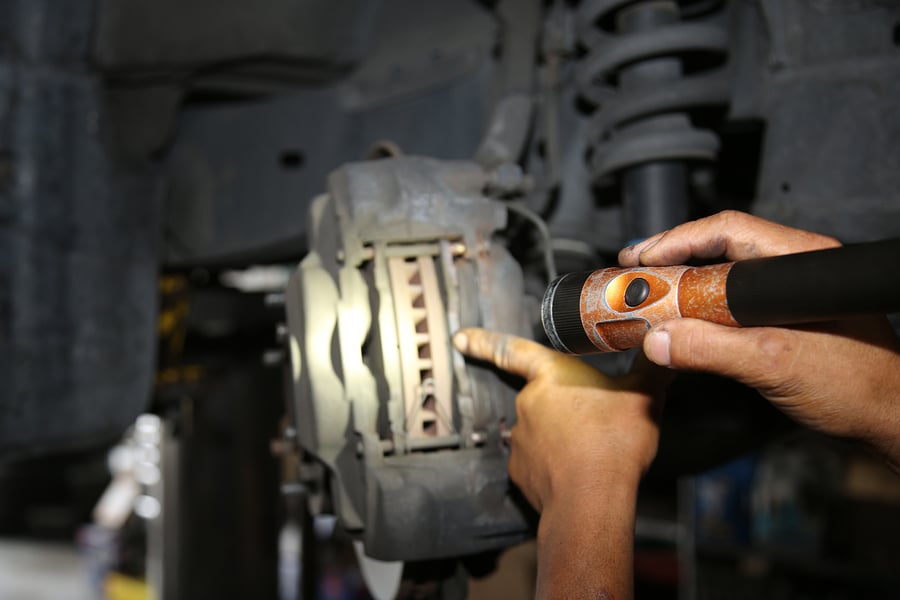
Generally speaking, most drivers, on any given day, pay little if any attention their brakes. That is until something goes wrong—a squealing or grinding noise, the feel of a soft brake pedal, a strange smell or one of those annoying lights glowing on the dashboard.
Today’s brake systems, especially since the 2004 mandate that all new cars must be manufactured with standard Anti-lock Braking Systems (ABS), are significantly more sophisticated than the relatively simple brakes of years past. And because of this complexity and the critical work they do, it is imperative that your car’s brakes be adequately serviced and maintained at all times.
Now, let’s take a closer look at the components of a typical brake system, what each part does and how to identify potential issues that may arise and require service.
Your Car’s Brake Components
– Master Cylinder and Brake Booster: Mounted directly in front of the driver on the firewall, inside the engine compartment, the role of the master cylinder and brake booster is to direct the brake fluid outward, through the brake lines to each wheel, where it compresses the brake pads, which then slows or stops the vehicle. A faulty master cylinder or brake booster, usually caused by leaking fluid, is commonly experienced as a soft brake pedal.
– Brake Fluid: A specialized oil that, through the function of the brake pedal, master cylinder, and brake booster, transfers hydraulic pressure to each wheel’s brake. This critical, yet the often-overlooked element of the braking system does require regular inspection. If water enters the system, the brake fluid can be compromised, which will affect the performance of the system.
– Brake Discs or Rotors: Most cars today use front and rear rotors, which are thick steel discs mounted on the front and rear axles. The car’s wheels are then mounted onto these discs. A warped brake disc can be felt as a vibration in the brake pedal.
– Drums: A few cars made today still use drum brakes, but only at the rear wheels. A brake drum is much thicker than a rotor as the brake shoes, springs and other components are mounted inside the housing.
– Calipers: Brake calipers are used only with rotors. They cradle the rotor and hold the brake pads, one mounted on each side. When the brake pedal is depressed, the fluid forces the brake calipers to compress the brake pads, pressing them into contact with the turning rotor, and that compression slows and stops the vehicle. A lousy brake caliper often exhibits many of the characteristics of other brake problems: a squealing or grinding sound, soft pedal, fluid leaking, car pulling to one side or even a burning smell while driving, which usually indicates that the caliper has frozen.
– Brake Pads or Shoes: The brake pads are mounted on the calipers for disc brakes, and brake shoes are mounted inside the drums. Most brake pads and shoes are semi-metallic or full-metallic, made up of a mixture of soft metals and bonded together. Because they are softer than the hard steel brake discs or drums, they wear out over time. A common sign of a worn-out brake disc is a metallic grinding sound coming from one or more wheel during braking. This typically means that the brake pad/shoe has worn down to its steel mounting plate, and that part is now coming in contact with the disc or drum. When this happens, not only do the brake pads require immediate replacement but most likely the brake disc or drum as well.
– Anti-lock Braking System (ABS): The Anti-lock Braking System is made up of wheel speed sensors, hydraulic motors, pressure release valves, and a control module. This complex, computer-managed system works by controlling the speed of each wheel during braking. When a wheel begins to lock up, perhaps caused by braking hard over a slippery surface, the ABS system immediately kicks in and creates a fast pulsating break/release that slows the vehicle, while also keeping it under control. Those who have experienced their ABS system in action will recognize it as a vibrational feeling while braking hard.
Braking Systems in Cars Are More Efficient and Safe
The good news is that the braking systems built into today’s cars are unquestionably more effective and safer than ever before. But the value of these systems can only be maximized by proper care and regular maintenance. If you experience any of the symptoms mentioned above, don’t ignore them. A reputable service center that does brake repair can perform a thorough inspection and advise of any components that need replacement. So don’t let what could be as simple as a routine brake pad replacement or brake fluid flush escalate into something much worse. Your safety and the safety of those around you depend on it.
